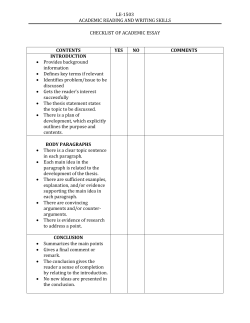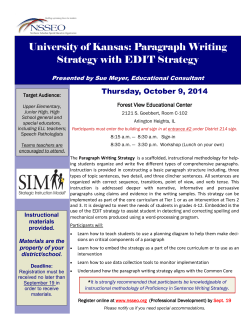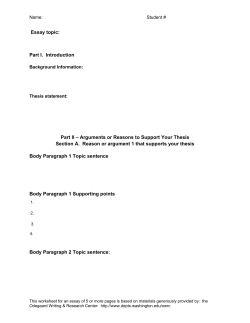
AP Language and Composition Summer Assignment
Summer Reading 2015-16 AP English Language and Composition Marjory Stoneman Douglas High School First, don’t panic. You will survive this summer reading and writing assignment and the AP Language and Composition course. You will struggle, but this is a normal part of the learning process. Second, take this seriously. This assignment is your ticket into class on the first day of school. If you have not turned this assignment into turnitin.com by Monday, August 24th, 2015, (before 7:40 AM) and you do not bring a hard copy to your first AP Language and Composition class, your first quarter grade will significantly suffer. All AP Language and Composition students are required to complete each of the following assignments. You have the entire summer to complete your work, but it is in your best interest to manage your time wisely to ensure that you are able to give each assignment your full effort without ruining the last three weeks of your break. We are delighted that you have elected to take Advanced Placement English Language and Composition next year. We think you will find the course to be challenging, enlightening, and a wonderful introduction to the college learning environment. First, some general information about the course: • Advanced Placement (AP) English Language and Composition examines the ways in which writers use language; consequently, the course requires both intensive reading of prose written in a variety of periods and extensive writing in multiple genres. Students read the works of many respected writers (predominantly, American) in numerous formats and genres- letters, short stories, novels, essays, speeches, autobiographies, and biographies- in order to examine how writers use language to persuade, educate, enrage, and even entertain. Writing ranges from informal, reflective journals to formal, critical papers, with an emphasis on analytical and argumentative writing which in turn perpetuates each student’s voice and command of syntax and diction. • Students enrolled in the course are required to take the College Board AP English Language and Composition examination in May. Thus, in addition to earning credit for Junior English, students have the opportunity to earn up to a year’s credit of college English, should they earn a qualifying score on the exam. In addition, successful students will emerge from this course with enhanced critical thinking skills, an enriched vocabulary, and the confidence to write effectively for their college courses and for their personal lives. Because of the intense nature of the course, it is essential that you complete the summer assignment which follows- preferably over the course of your summer rather than the week before school starts. The assignment is intended to acquaint you with the types of works we will be studying and the approaches we will be employing in analyzing such works. Note that your assignment includes the reading of two nonfiction books, the reading of speeches (non-fiction), and the study of various news sources. DO YOURSELF A BIG FAVOR: DO NOT WAIT UNTIL THE LAST WEEK OF SUMMER TO BEGIN THIS ASSIGNMENT. All assignments must be turned in to turnitin.com BEFORE 7:40 AM on the first day of school. **** Please submit all of this work to turnitin.com as well as in hard copy form on day one of class. Class name: Summer Work 2015 Password: welcome (case sensitive) Class ID: 9954027 For students who are new to Stoneman Douglas, you will have about two weeks to complete the summer assignment once we return to school. Assignment One: Tone and Mood Words 1. Using the “Tone and Mood Words” handout, define the words you do not know from the list. You will have a quiz within the first two weeks of school on all of the words. You are creating a study guide for yourself and will be required to keep a section of your binder for Tone/Mood words. Assignment Two: Speeches/Documents The Summary Paper: As you read the following speeches, annotate (make notes on the main assertions, rhetorical devices used, figurative language, central ideas and purpose of each speech); this will enable you to complete a summary of each speech. YOU WILL LOSE CREDIT IF SPEECHES ARE NOT ANNOTATED. Please note: HIGHLIGHTING is NOT ANNOTATING!! Note: You may want to make a list of your annotations to help you formulate your summary paper. For each speech, you will write a summary of approximately 300 words. Make sure to include the main idea and supporting assertions. Ensure that your summary accurately and economically expresses the central ideas of the original. The following are helpful hints for you: • “I Have a Dream” Speech In King’s speech, virtually every paragraph can be summarized in one sentence. Several repetitive paragraphs can be summarized in one sentence. Reread the 2030 sentences you have written on the speech/or on the list to be sure that your sentences accurately, clearly and economically express the central ideas of the original. The speech can be summarized in 20-30 sentences. • Patrick Henry’s “Give Me Liberty or Give Me Death” Speech In this passage, every paragraph can be summarized in 3-5 sentences. Reread the 12-20 sentences you have written to be sure that your sentences accurately, clearly and economically express the central ideas of the original. • Declaration of Independence This speech is much like King’s in that it has many short repetitive paragraphs. Several repetitive paragraphs can be summarized in one sentence. Reread the 2030 sentences you have written to be sure that your sentences accurately, clearly and economically express the central ideas of the original. Some Advice: I. Before writing your summary paper, read the speeches SEVERAL times carefully to determine each thesis…The writer’s position. Distinguish between those assertions which the speaker make to develop his thesis and the evidence he uses to support such assertions. o Look for the topic sentence of each paragraph, but do not assume that every paragraph treats a separate, equally important topic. Sometimes a writer will elaborate or develop a single point for several paragraphs. o Isolate these single points (assertions) and examine their relationship to each other o It may help to outline the main points (the main assertions) of the speech, realizing that the outline may or may not precisely reflect the organization of the original speech. II. The summary should be entirely your own words. To duplicate the phrasing of the original without quotation constitutes plagiarism. You will find this formula for the first sentence to be helpful: In his speech “I Have a Dream,” Martin Luther King Jr. asserts that… Following the word that will embed a thesis sentence that summarizes King’s own thesis. III. In the speeches, virtually every paragraph can be summarized in one sentence. Several repetitive paragraphs can be summarized into one sentence. Summarize each paragraph or paragraph block in one sentence. Then read the sentences you have written. In your revision be sure that your sentences accurately, clearly, and economically express the central ideas of the original. Advice: Keep the use of quotations to a bare minimum. You may wish to integrate an important phrase, but the bulk of your summary paper must be in your own words. Any quotations should be fully integrated in your writing. Avoid the temptation to end your paper with a quotation. (Such an ending is rarely advisable.) Do not impose your ideas or opinions on the original Do not merely rephrase or paraphrase. You cannot possibly reproduce every idea in the speech. Select and summarize only the central ones. (Keep in mind there is a difference between summary and paraphrase) Use the present tense. For example, “King asserts…” The speech and the ideas it presents exist in the present. However, past tense or future tense must be used when necessitated by the context. In other words, if the author discusses an event that occurred in the past, the event happened, if the author discusses a future consequence, the consequence may ensue. Do not attempt to analyze or evaluate what the author does; merely summarize what the writer writes. Use effective, precise words. Verbosity torpedoes effective writing. Remember that the word “this” is not the subject of a sentence, so we will not be reading any sentences that begin: “This means that…” or “What this means is that….” Your summary paper should be typed 1-inch margins, double spaced, 12 point font (Times New Roman) approximately 2-5 pages. The paper must include three wellwritten summaries of the speeches. You MUST turn in your annotated speeches with this paper. They will be returned to you. Assignment Three: Short Readings and The Art of Argument/Rhetoric The following 18 readings can be found on Mrs. Edgar’s MSD website. None of the readings are longer than three pages, and the entire list can be completed in a single evening. These readings will help you to understand the art of rhetoric-how we persuade others, through language, to think or act the way we want them to. You should print each of the readings (some will be a part of this summer assignment and the others will be completed in class so they should be in your AP binder). For EACH of the following assigned summer essays, • • • • • • • • • “Remedial Reading” (narration) “The Gramercy Gym” (description) “The Great American Desert” (example) “A Few Words for Motherhood” (process analysis) “Sitters and Squatters” (comparison and contrast) “Here is New York” (classification and division) “Inside the Interrogation Room” (analogy) “The Meaning of Home” (definition) “Why We Crave Horror Movies” (cause and effect) you should recreate and complete the following chart: Essay Title: Reader Response: • Your reactions/emotional responses (humor, surprise, sadness, anger, frustration, tension, criticism, confusion) • Your questions or lack of understanding or doubts (ask “why”) Responses Your revelations (when “things” become clear to you, when you create links between ideas) • Similarities to other works (This reminds me of…) • Wonderful writing-passages that strike you artistically/aesthetically and why Speaker: Think about who the writer is and what he or she NEEDS to communicate. This should help you determine the author’s credibility. • Introductory facts (author backgrounds and relationship to the topic, bias, etc.) • Ethos-how does the author establish credibility and character on the given topic? • Note words and language that indicate the author’s attitude or tone and where it shifts. • Note when the author directly or indirectly states how he or she feels • Observe key lines that stand out as crucial to the author’s argument. • Occasion: Think about what caused the author to write about this topic and whether or not it is a valid reason. • The author’s reasons for writingwhat is the motivation? • Historical, political, and social issues surrounding the topic • The author’s personal reasons as well as the greater world influences for the piece • Evidence of views characteristic of the time period and culture surrounding the work. • Descriptions of class judgments, racism, gender biases, stereotypes, etc. Audience: Think about what kind of person or people the author intended to view the piece. Is the author able to connect with that audience effectively? • Evidence of who the author is trying to reach. • Where the author directly or indirectly addresses a specific audience. • Any “call to action” that the author is issuing to the reader. • Pathos-does the author appeal to your sense emotion through anecdotes and figurative language. Purpose: Think about the author’s purpose in writing this book and whether or not he or she is effective in that purpose. • Specific reasons for writing (informing, persuading, arguing, refuting, exemplifying) • Logos-the author’s appeal to reason. Examine how the author makes the reader believe in that purpose. Subject: Think about what the book is discussing and whether or not the author shows why this subject matter is important. • Elements related to the problem or issue. • How the author develops or deepens the aspects of the problem or issue. • How the author shows the complications related to the subject and the implication of it to you, the nation, the world, etc. Authorial Devices and Structure in the Argument: Think about the author’s techniques in delivery and how effective the author’s methods are for rhetorical purpose. • Changes in point of view/emphasis. • Crucial language/vocabulary (not just a word that you don’t understand, but one that seems crucial to understanding the argument) • Stylistic techniques (irony, satire, humor, exaggeration, repetition/patterns, possible symbols, significant metaphors and other notable literary and rhetorical devices). • How the author’s structure of the argument /book influences the reader and relate to the subject, audience, and purpose. Assignment Four: Read the following book and complete the assignment for the book: • Thank You For Arguing Revised and Updated Edition (2013) by Jay Heinrichs **WE strongly recommend note taking or annotating while reading. For each chapter, focus on the themes, new vocabulary words, argument construction, and language choices. Assignment: Read the first 17 chapters (pages 1-198) and complete the following tasks: Part 1: Select at least 6 specific techniques for effective argument that you learned or understood better because of reading this book. Describe each technique in a separate paragraph. Make sure to give the name of the technique, an explanation of what it means, and an example. Cite page numbers for each technique. Part 2: Recall an argument from your past that you “lost”. (Your account could be an argument with a friend, a sibling, a teacher, a parent, etc.) Briefly rewrite the argument in dialogue form- like the script of a play. First, show how the argument went originally. Then rewrite it to show how the argument could have ended differently, had you known some of the techniques or skills that you have read about in TYFA. Label the techniques/ skills you use in the rewritten version in the margin. Assignment Five: Purchase a copy (used is fine!) or borrow from a local library The Overachievers The Secret Lives of Driven Kids by Alexandra Robbins. **The EHS Club at Stoneman Douglas High School has copies available for purchase ($10.00) in Mrs. Amelkin’s room 168. Buy copies while they last!!! Read chapter 1, “Meet the Overachievers.” As you read, choose one of the following students: Julia, Audrey, AP Frank, Taylor, Sam, Pete, Ryland or C.J. . Then read only the sections that profile the student you have chosen. As you read, take notes on the student you select and note any thoughts you have that are inferred or that cause you to have an opinion of that particular student. When you are done reading, create a character profile, which is a personal statement essay written from the point of view of that student that explains how his or her “perceived as” label is accurate as well as inaccurate. The essay should include why you (as that student) are deserving of admittance to the colleges you are applying to. You should truly feel as if you know the student and may even think of him or her as someone you would like to have as a friend. Finally, read pages 390-400. Write a response to the ideas that Alexandra Robbins puts forth regarding “what schools can do.” Assignment Six: Assemble an AP Language Notebook using a three ring binder. There will be MANY handouts, so plan accordingly. 1. Include a few dividers: purpose will be discussed in class. How To Present Your Summer Reading Assignment to Your AP Language and Composition Teacher In a three-ring binder, submit your assignments in the following order: **Each section should be clearly labeled. 1. Tone/Mood Words 2. Summary paper of speeches. **The annotated speeches MUST be in the side pocket of the folder. 3. Readings: Art of Argument and Rhetoric-be certain each essay is labeled. 4. Thank You For Arguing assignment 5. The Overachievers: Character personal statement. 6. Turnitin.com receipt – first page only Bring your summer assignment binder and class binder to school on the first day. Have a wonderful summer!
© Copyright 2025











